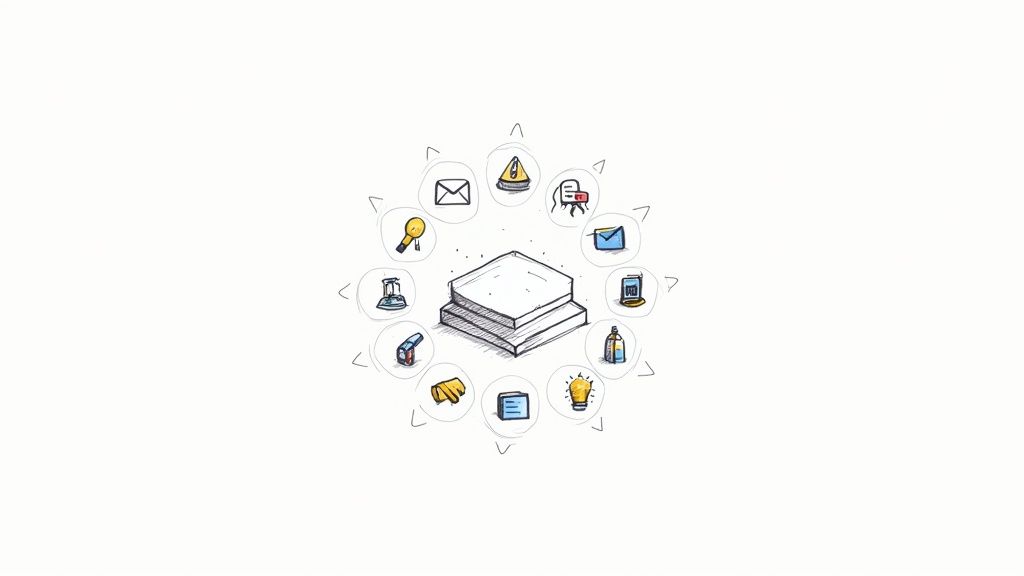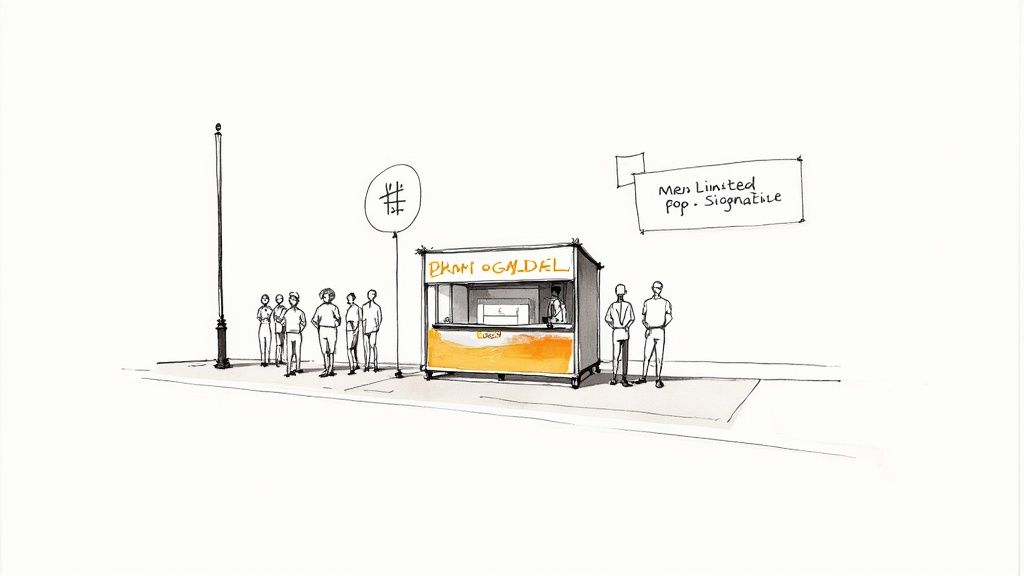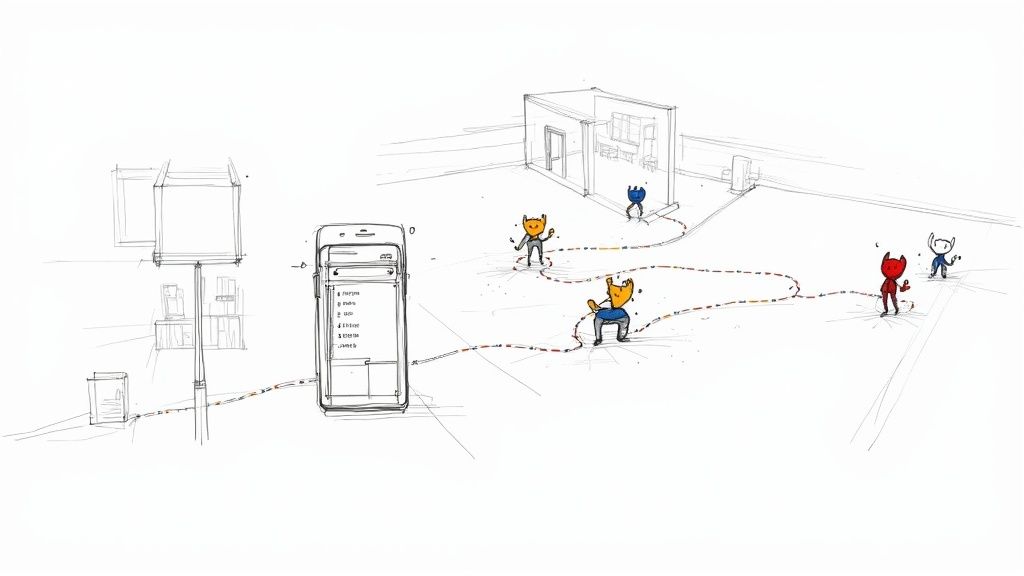October 22, 2025

In a crowded market, generic event promotion falls flat. To capture attention and drive registration, you need innovative event marketing ideas that create genuine excitement and deliver tangible value long before the doors open. This guide moves beyond the basics of email blasts and social media posts, offering a deep dive into 10 cutting-edge strategies that not only sell tickets but build lasting communities.
We'll explore how to transform passive attendees into active brand advocates, from crafting immersive experiential events to leveraging data-driven personalization. For each powerful idea, we will provide specific, actionable steps for implementation. When rethinking your event marketing strategy, integrating tangible brand touchpoints can be highly effective. For guidance on this, discover 15 tips for choosing the best promotional products that truly resonate with your audience and event goals.
Furthermore, we'll demonstrate how an all-in-one platform like GroupOS can streamline execution, helping you manage everything from ticketing and audience engagement to post-event analytics seamlessly. Get ready to supercharge your next event with practical strategies designed for maximum impact, turning every touchpoint into an opportunity for connection and growth.
Experiential marketing moves beyond passive attendance, transforming your audience into active participants. Instead of telling them about your brand, you create a tangible, multi-sensory environment where they can feel, touch, and interact with it directly. This approach forges strong emotional connections and generates lasting brand recall, making it one of the most powerful event marketing ideas for building a loyal community.
These events are designed to be memorable and shareable. Think of Refinery29's "29Rooms," an immersive art installation where each room offers a unique, Instagram-worthy experience. This model thrives on user-generated content, turning every attendee into a potential brand ambassador. The goal is to create a "you had to be there" moment that generates significant online buzz.
To create a successful experiential event, focus on a core brand message and build an interactive narrative around it.
GroupOS Pro-Tip: Use GroupOS to manage a multi-layered event experience. Create dedicated channels for different interactive zones, allowing attendees to share photos and connect with others in real-time. You can also use polls and Q&A features to gather instant feedback on which installations are generating the most engagement, helping you measure impact on the spot.
Hybrid events merge the energy of a physical gathering with the accessibility of a virtual one, allowing on-site and remote attendees to participate simultaneously. This dual-audience approach dramatically expands your reach, breaking down geographical and logistical barriers. By offering both experiences, you can capture a global audience without sacrificing the valuable intimacy of face-to-face interaction, making it one of the most versatile event marketing ideas available today.
This model has been successfully adopted by industry giants like Salesforce for its Dreamforce conference and HubSpot for INBOUND. They offer high-value in-person experiences while broadcasting keynotes and sessions to a massive online audience. This strategy not only boosts attendance numbers but also creates a more inclusive and flexible event format that caters to diverse audience needs and preferences.
A successful hybrid event requires a deliberate strategy that serves both audiences without compromising either experience.
GroupOS Pro-Tip: Use GroupOS to unify your hybrid event experience. Create a central community hub where both in-person and virtual attendees can access agendas, participate in discussions, and network before, during, and after the event. Use dedicated channels for virtual-only sessions and others for in-person networking to ensure everyone finds relevant conversations and connections.
Collaborating with social media influencers and content creators allows you to tap into pre-built, engaged communities. Instead of building an audience from scratch, you partner with trusted voices who can authentically promote your event to their loyal followers. This strategy amplifies your reach and builds credibility, making it one of the most effective event marketing ideas for driving ticket sales and generating buzz.
Brands like Revolve have built their entire marketing model around exclusive, influencer-centric events, while festivals like Coachella leverage creators to set annual trends. The key is to treat influencers as genuine partners, not just walking advertisements. When creators are genuinely excited about an event, their followers notice, leading to organic and powerful promotion before, during, and after the occasion.
To effectively forge strategic influencer and creator partnerships, reviewing powerful influencer marketing campaign examples can inspire and guide your own initiatives.
GroupOS Pro-Tip: Create a private, invite-only GroupOS channel exclusively for your event influencers and creators. Use it to share important updates, logistical details, and exclusive content previews. This streamlined communication hub makes them feel like valued insiders and helps you manage the partnership program efficiently.
Guerrilla marketing and pop-up events disrupt the ordinary by creating unexpected brand activations in high-traffic public spaces. These temporary experiences generate excitement through scarcity and surprise, transforming a simple encounter into a memorable, shareable moment. This strategy is one of the most effective event marketing ideas for creating a viral buzz and capturing audience attention in an authentic, ground-level way.

These activations thrive on creating a sense of urgency and exclusivity. Think of Glossier's city-specific pop-up installations that become instant destinations or Netflix's immersive set recreations for shows like Stranger Things. The goal is to create a powerful "you had to be there" feeling that drives immediate social media chatter and foot traffic, often turning the queue itself into a marketing tool. For more inspiration, explore these innovative promotion ideas for events.
Success with this tactic relies on meticulous planning and a bold creative concept that stops people in their tracks.
GroupOS Pro-Tip: Use GroupOS to capture leads and build a community from your pop-up traffic. Create a simple QR code that links to an event landing page where visitors can sign up for your community, enter a giveaway, or access an exclusive offer. You can then nurture these new connections long after the temporary event has ended, turning fleeting interest into lasting loyalty.
User-generated content (UGC) campaigns turn your audience into an authentic marketing force. Instead of broadcasting your own message, you empower attendees to create and share their experiences, leveraging their social proof and organic reach. This strategy transforms passive participants into active brand advocates, amplifying your event's visibility far beyond the venue walls. It’s one of the most cost-effective event marketing ideas for generating genuine buzz.
This approach capitalizes on the trust consumers place in peer recommendations over brand advertising. Campaigns like SXSW's iconic #SXSW hashtag, which generates millions of posts, or Coca-Cola's event-integrated #ShareACoke campaign showcase how UGC can create a global conversation. The goal is to make sharing an integral and rewarding part of the event experience itself, driven by authentic enthusiasm.
A successful UGC campaign is built on clear incentives and frictionless sharing. It should feel natural, not forced.
GroupOS Pro-Tip: Use GroupOS to supercharge your UGC campaign. Create a dedicated event feed where attendees can post photos and videos directly within the community platform. Run a "Best Post" contest using the polling feature to let the community vote for their favorite submissions, and use push notifications to announce winners and remind attendees to share their experiences using the event hashtag.
Collaborating with complementary brands allows you to tap into new audiences and share resources, dramatically amplifying your event's reach while managing costs. Instead of marketing in a silo, co-marketing creates a powerful synergy where both partners benefit from shared credibility, expanded promotional channels, and a richer event experience for attendees. This approach is one of the most efficient event marketing ideas for scaling your impact.
This strategy is about finding a partner whose audience overlaps with yours but doesn't directly compete. Think of the classic Red Bull and GoPro partnership, where both brands co-sponsor extreme sports events, appealing to the same thrill-seeking demographic. The combined marketing efforts create a more significant cultural moment than either brand could achieve alone, generating massive cross-promotional value and solidifying their market positions.
Successful co-marketing hinges on clear communication, aligned goals, and mutual benefit. Start by identifying potential partners whose brand values resonate with yours.
GroupOS Pro-Tip: Use GroupOS to create a shared, private channel exclusively for your event partners. This centralized hub is perfect for coordinating logistics, sharing marketing assets, and keeping all stakeholders aligned throughout the planning process. You can also track referral traffic from each partner's promotions to measure their individual impact on ticket sales and registrations.
Gamification integrates game-like mechanics such as points, badges, and leaderboards into your event to boost engagement and guide attendee behavior. By using interactive tech like event apps, AR/VR, or RFID/NFC, you transform passive participation into an active, rewarding experience. This strategy is one of the most effective event marketing ideas for increasing booth traffic, session attendance, and networking.

This approach makes mundane tasks feel exciting and encourages exploration. For instance, SXSW has used badge-scanning scavenger hunts to drive attendees to specific locations, while Salesforce’s Dreamforce gamifies its agenda to incentivize session participation. The goal is to create a fun, competitive atmosphere that aligns with your key event objectives, making the experience more memorable and measurable.
To successfully implement gamification, design challenges that are simple, intuitive, and clearly tied to your event goals.
GroupOS Pro-Tip: Build your gamification strategy directly into the GroupOS platform. Create challenges like "visit 5 sponsor booths" or "connect with 10 new people" and use our check-in and networking features to automatically award points. Display a live leaderboard in the event feed to fuel friendly competition and use analytics to see which activities are driving the most participation.
Positioning your event as an indispensable educational hub is a powerful strategy to build brand authority. Instead of focusing solely on your products, you provide immense value through high-caliber speakers, in-depth workshops, and exclusive insights. This approach attracts a highly engaged audience eager to learn, network, and discover emerging industry trends, making it one of the most effective event marketing ideas for establishing credibility.
These events transform your brand into a trusted knowledge source. Think of HubSpot's INBOUND conference, which draws tens of thousands with its focus on marketing, sales, and service education from industry pioneers. Attendees don't just come for a sales pitch; they come to gain actionable skills and insights, creating a powerful positive association with the host brand. The goal is to become the go-to event for professional development in your niche.
To create a successful thought leadership event, curate content that is both aspirational and practical, ensuring attendees leave with tangible takeaways.
GroupOS Pro-Tip: Use GroupOS to build a year-round knowledge community around your event. Create dedicated channels for each content track where attendees can ask speakers follow-up questions, share notes, and continue discussions long after the event ends. You can also poll your community before the event to identify the most in-demand topics, ensuring your agenda is perfectly aligned with audience needs.
Aligning your event with environmental or social causes taps into the growing consumer demand for brand responsibility. Instead of being just another conference or gathering, your event becomes a platform for positive impact, attracting attendees who share your values. This approach builds brand affinity on a deeper level, transforming your marketing into a mission-driven statement and making it one of the most resonant event marketing ideas for modern audiences.
These events prioritize purpose over simple promotion. Think of Patagonia’s "Worn Wear" tour, which offers free repairs on clothing to promote sustainability and circular fashion. This model doesn't just market a product; it markets a philosophy. The goal is to demonstrate your brand's commitment to a cause, creating an authentic connection that inspires loyalty and positive word-of-mouth far beyond the event itself.
To execute a successful cause-driven event, integrate your mission into every aspect of the planning process, from logistics to programming.
GroupOS Pro-Tip: Use GroupOS to highlight your event's mission. Create a dedicated community channel for sustainability discussions, share updates on your impact goals, and use polls to ask attendees which causes they care about most. You can also use the platform to facilitate a post-event fundraiser or volunteer drive, extending the event's positive impact long after it concludes.
Move beyond one-size-fits-all event programming by leveraging attendee data to create a uniquely tailored experience for every participant. Instead of presenting a generic agenda, this strategy uses insights gathered during registration and through in-app behavior to offer personalized session recommendations, networking suggestions, and content. This approach makes each attendee feel seen and valued, dramatically increasing engagement and perceived event value.
This method transforms data from a simple registration tool into a powerful personalization engine. For example, Salesforce uses its Einstein AI at Dreamforce to suggest relevant sessions and connections, while Adobe Summit provides attendees with a personalized dashboard. These powerful event marketing ideas ensure participants get the most relevant experience possible, which boosts satisfaction and makes them more likely to return for future events.
To execute a data-driven event, you must build a personalization strategy that begins long before the event day.
GroupOS Pro-Tip: Utilize GroupOS’s custom registration forms to collect detailed attendee data from the start. Our platform can then use this information to create segmented communication channels and personalized event tracks. You can create dedicated groups for VIPs, first-time attendees, or specific interest areas, delivering targeted content and facilitating more meaningful connections throughout the event.
We've explored a wide spectrum of powerful event marketing ideas, from the immersive power of experiential activations to the targeted precision of data-driven personalization. Each concept, whether it's a dynamic hybrid event or a sustainability-focused initiative, offers a unique pathway to capture attention, engage audiences, and drive meaningful results. However, the true magic isn't in deploying one of these ideas in isolation; it's in weaving them together into a cohesive, unified strategy.
The most successful event marketers understand that the attendee journey is not a series of disconnected touchpoints. It's a continuous narrative that begins long before the event doors open and extends well after the final session concludes. An influencer partnership should seamlessly funnel attendees into a personalized registration flow. A user-generated content campaign should feed directly into on-site gamification. A thought leadership webinar should serve as the perfect prelude to an in-person conference. This interconnected approach transforms a one-off event into a lasting community-building engine.
To turn these concepts into measurable success, focus on three core pillars:
Ultimately, mastering modern event marketing is about shifting your perspective from hosting events to building communities. It’s about creating experiences that are so valuable, engaging, and memorable that attendees feel a genuine sense of belonging and eagerly await your next gathering. By adopting these event marketing ideas and integrating them into a unified, technology-powered strategy, you can create a powerful flywheel of engagement that drives growth, loyalty, and long-term impact for your organization.
Ready to unify your event strategy and bring your best event marketing ideas to life? GroupOS provides an all-in-one platform designed to manage, measure, and scale your community and events. Explore how GroupOS can centralize your efforts and turn brilliant ideas into unforgettable experiences.


